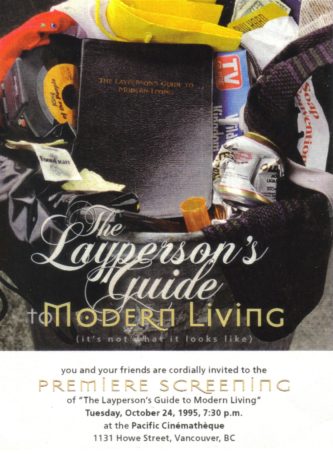 Have you seen THE LAYPERSON’S GUIDE TO MODERN LIVING? No? Don’t worry, neither has 99.9 percent of the rest of the world.
Have you seen THE LAYPERSON’S GUIDE TO MODERN LIVING? No? Don’t worry, neither has 99.9 percent of the rest of the world.
THE LAYPERSON’S GUIDE TO MODERN LIVING is a 1995 anthology feature made in Canada for around $60 grand CDN. It was never screened anywhere outside a few obscure film festivals, and isn’t even listed on the Internet movie database. It does exist, though; I should know, as I was one of the screenwriters.
Have you seen THE LAYPERSON’S GUIDE TO MODERN LIVING? No? Don’t worry, neither has 99.9 percent of the rest of the world.
Many independent movies, from THE EVIL DEAD to EL MARIACHI to THE BROTHERS MCMULLEN, made with low to nonexistent funds, have gone on to make millions and initiate successful Hollywood careers for their makers. Those films were certainly on my mind when I, together with some film school chums, concocted what was at the time called BAR NIGHT. Its subsequent production and (non) reception are all-too symptomatic of what happens to the rest of the “indies” made in North America and, more importantly, demonstrates what NOT to do when making an independent feature…meaning you aspiring filmmakers are advised to pay the following account close attention!
It does exist, though; I should know, as I was one of the screenwriters.
There I was back in March of ’95, having recently graduated from the Vancouver Film School. With a group of fellow graduates—Martin, Tom and Craig (to protect the guilty, no last names will be provided)—I enrolled in a post-graduate course held by the school (providing us with a good excuse not to go out and find jobs) where the idea for our no-budget opus was formed.
Encouraged by our professor, we each concocted and scripted a segment of the proposed movie, which we would then direct ourselves. Never mind that I was aware even then that most anthology films suck (see FOUR ROOMS, SPIRITS OF THE DEAD, ROGOPAG, NEW YORK STORIES, ARIA, THE STRANGE WORLD OF COFFIN JOE, etc.); ours would somehow be different…or so I thought.
As I recall, I wrote my segment, “Wilder Kingdom,” over the course of a weekend. We then discussed it in class, after which I did a quick rewrite and my contribution to the film was finished.
My money was running out, meaning I could no longer put off returning to the states and finding work. This effectively put an end to the prospect of me directing, so “Wilder Kingdom” ended up helmed by Martin, who also wrote and directed two of the movie’s other five parts. Another was written and directed by Craig and the last by Shannon, who was in LA at the time but eventually flew back to Vancouver in June (long after I’d left the picture).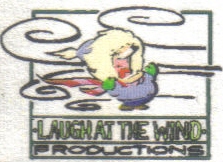
Things got rolling. Tom and Martin, the producers (whose respective parents largely financed the film) formed Laugh At The Wind Productions, drew up complex cost sheets and shooting schedules, hired a lawyer and opened a special bank account.
It was in those early days, it seems, that the seeds of the film’s destruction were sown.
It was in those early days, it seems, that the seeds of the film’s destruction were sown. In contrast to the accounts of frenzied, all-inclusive pre-production activity recorded in Robert Rodriguez’s REBEL WITHOUT A CREW (about the making of EL MARIACHI) and J.R. Bookwalter’s B MOVIES IN THE NINETIES AND BEYOND (which profiled its author’s career in the B-movie arena), the pre-production of BAR NIGHT was rather leisurely. There were certainly no worries about money; whenever the funds ran low, Tom and Martin simply wrote home and requested more.
My own involvement with the movie ended in late April, when I flew back to the states. First, though, we all had a meeting in the lobby of my apartment, where plans for BAR NIGHT were finalized. Shooting, as I recall, was set to start in June and end in early August, with an extra month’s time allotted for editing. I felt the schedule was a bit unrealistic, but, seeing as how I wasn’t going to be around, kept my mouth shut.
Fast-forward about four months. I was back in LA and had pretty much forgotten about BAR NIGHT, until one day when, out of the blue, I received a phone call from Martin. The film, he said, was just about finished, but he needed me to write some extra dialogue for a voice-over portion of “Wilder Kingdom.” I promptly wrote and sent off the dialogue, and a few weeks later received an invitation to the premiere screening of the finished film, now titled THE LAYPERSON’S GUIDE TO MODERN LIVING.
I promptly wrote and sent off the dialogue, and a few weeks later received an invitation to the premiere screening of the finished film, now titled THE LAYPERSON’S GUIDE TO MODERN LIVING.
Excited about the possibility of hearing my words spoken by real actors on an actual movie screen, I flew to Vancouver for the screening. The Vancouver Cinematheque was rented out for a 7PM screening, which as it turned out was so crowded an extra showing had to be set up two hours later.
The night, in short, was a roaring success. Seeing my script played out was every bit as exciting as I’d anticipated, and the audience had a ball, laughing and applauding throughout (which is to be expected from a theater packed with friends and relatives of the cast and crew). Craig even dubbed it “the best night of my life.”
The audience reaction, it seems, had an adverse effect on all of us: it made the film seem a hell of a lot better than it was. I myself was quite impressed with what I saw…until the next day, when I tried watching the tape I’d been given. My reactions then, away from the excitement of the premiere, were far less effusive. Just in case you care, here’s a mini-review of THE LAYPERSON’S GUIDE TO MODERN LIVING.
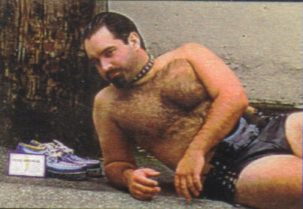 First, the name itself. BAR NIGHT, while not much of a title, is at least short and snappy. But THE LAYPERSON’S GUIDE TO MODERN LIVING? Talk about a mouthful! It is, however, fairly representative of the film itself: bland and forgettable.
First, the name itself. BAR NIGHT, while not much of a title, is at least short and snappy. But THE LAYPERSON’S GUIDE TO MODERN LIVING? Talk about a mouthful! It is, however, fairly representative of the film itself: bland and forgettable.
But anyway: the film, after a brief montage introducing the central characters of the five segments, starts out with “Wilder Kingdom,” scripted by me. The darkly comedic story (as it turns out, it’s the only one of the five with anything resembling a story) concerns a bored housefrow obsessed with a perverted reality TV show and looking to spice up her sex life; in the course of a few hours, she and her husband have a blow-out, he lands in jail wearing leather bondage gear and she ends up with her neighbor literally stuck inside her on national TV (don’t ask). Sounds pretty wild, yet under Martin’s direction the segment, while true to my script (which in Martin’s defense was far from Shakespeare), somehow ends up replicating the suffocating blandness of the rest of the film.
But anyway: the film, after a brief montage introducing the central characters of the five segments, starts out with “Wilder Kingdom,” scripted by me.
The following segments “Buy Hard” and “Soap Convention,” both written and directed by Martin, are astoundingly boring, witless crap about, respectively, two old ladies who scam a department store out of thousands of dollars worth of merchandise and a TV executive board meeting that turns into a discussion of a soap opera produced by a rival network.
Next up is Craig’s “King of the People,” a meandering account of a slacker’s encounter with a freak who thinks he’s Elvis. This one, unlike the previous two, has some good moments, but it drags on 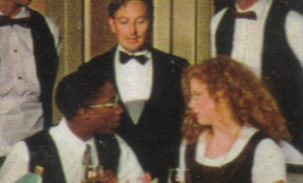 for too damn long. Last is Shannon’s “Food Fight,” about two obnoxious yuppies on a date in a fancy restaurant; the dialogue is snappy, but it’s not enough to keep it afloat, and neither is the conceit of intercutting a pool game with the conversation (when the guy says something resonant a ball goes into a pocket, but when he says the wrong thing the balls miss their targets—this is precisely the type of idea that might seem cool in script form but doesn’t translate at all well to the screen).
for too damn long. Last is Shannon’s “Food Fight,” about two obnoxious yuppies on a date in a fancy restaurant; the dialogue is snappy, but it’s not enough to keep it afloat, and neither is the conceit of intercutting a pool game with the conversation (when the guy says something resonant a ball goes into a pocket, but when he says the wrong thing the balls miss their targets—this is precisely the type of idea that might seem cool in script form but doesn’t translate at all well to the screen).
The film’s lighting and compositions all but scream out amateurism, not helped by the cheap film stock and the fact that the camera is kept obnoxiously static throughout (see this film and you’ll understand the wisdom of Roger Corman’s advice to novice filmmakers: “Always keep the camera moving!”). The one high point is the acting, which is, surprisingly, pretty solid throughout; it’s what makes the film a forgettable mediocrity rather than a total disaster (which, truth be told, might have made for a more entertaining product).
I’ll also criticize the way the film was sold. The poster art created by Tom and Martin (together with Beth, a colleague who worked for a printing company) looks more like a menu than an advertisement for a film. Even worse is the tagline “It’s not what it looks like” (a reference, apparently, to the giant trash can pictured on the poster). So what is it, then? The promotional blurb—“The bizarre happenings in the five short stories of THE LAYPERSON’S GUIDE TO MODERN LIVING examine some of the essential elements of modern life…and we find that the omnipresent surface of normality is nothing but a big cover-up!”—doesn’t exactly inspire confidence, and neither does the closing line informing us that the film was created by “a group of film school graduates who decided to forego those PA jobs and instead put together their own feature…”
Even worse is the tagline “It’s not what it looks like” (a reference, apparently, to the giant trash can pictured on the poster).
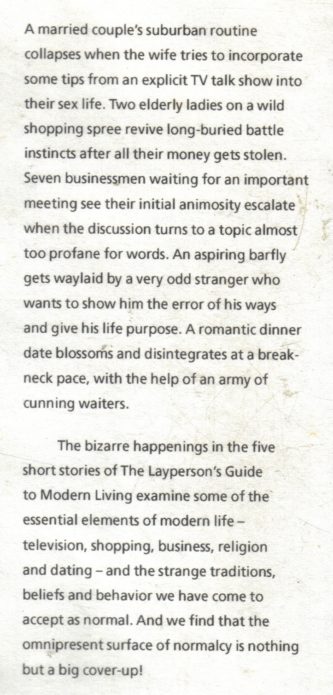 So what eventually happened with THE LAYPERSON’S GUIDE TO MODERN LIVING? Nothing, really. It faded into oblivion while we the filmmakers all went about our lives.
So what eventually happened with THE LAYPERSON’S GUIDE TO MODERN LIVING? Nothing, really. It faded into oblivion while we the filmmakers all went about our lives.
Sure, attempts were made to find a distributor, but, unsurprisingly, nobody was interested. It somehow won an award at a Canadian film festival (where a patron reportedly got quite upset at what he perceived as pedophiliac overtones in my segment), which did little to bolster its profile. It was submitted to Sundance and rejected. I tried to drum up some publicity on my own by sending a VHS copy to Shock Cinema‘s Steve Puchalski, but never received a response, much less a review (Steve’s only acknowledgement was a back-handed one, in a subsequent editorial advising against sending unsolicited videos).
We’ve all heard no-budget fairy tales, particularly in the horror genre, where it often seems like budget-lite success stories are the norm. CARNIVAL OF SOULS, NIGHT OF THE LIVING DEAD, THE TEXAS CHAINSAW MASSACRE, HALLOWEEN, PHANTASM, BASKET CASE, THE DEAD NEXT DOOR and THE BLAIR WITCH PROJECT were all made for very little money, yet all went on to achieve great things for their makers. Ditto more mainstream fare like EL MARIACHI, CLERKS and THE BROTHERS McMULLEN.
What you don’t hear about are those other no-budgeters, the ones that don’t achieve fame or fortune and wind up as expensive tax write-offs languishing in somebody’s basement. It’s these latter items that comprise the majority of North American indies—about 95 percent worth (or more). Consider: over 3,000 films are submitted to the Sundance Film Festival each year for a scant 16-entry competition.
In other words, for every BLAIR WITCH PROJECT there are hundreds of LAYPERSON’S GUIDE TO MODERN LIVINGS.
For aspiring independent filmmakers the chances of creating a successful movie are at best pretty slim. Then again, though, it’s possible you might have better luck than we did, provided you come up with a compelling story and characters, put careful thought into publicizing your film and just give it everything you’ve got; we only gave 50-75 percent at best, and it shows.
Of course, if you’d like to see for yourself just what we did capture onscreen, I can sell or trade you a copy of THE LAYPERSON’S GUIDE TO MODERN LIVING. Interested?
I didn’t think so.
